Investigation of the Optical Nonlinearity for Au Plasmonic Nanoparticles Based on Ion Implantation
Abstract
:1. Introduction
2. Materials and Methods
Au NP-SA Sample Preparation and FDTD Simulation
3. Results and Discussion
4. Conclusions
Author Contributions
Funding
Data Availability Statement
Conflicts of Interest
References
- Schuller, J.A.; Barnard, E.S.; Cai, W.; Jun, Y.C.; White, J.S.; Brongersma, M.L. Plasmonics for extreme light concentration and manipulation. Nat. Mater. 2010, 9, 193–204. [Google Scholar] [CrossRef]
- Nishijima, Y.; Ueno, K.; Yokota, Y.; Murakoshi, K.; Misawa, H. Plasmon-Assisted Photocurrent Generation from Visible to Near-Infrared Wavelength Using a Au-Nanorods/TiO2 Electrode. J. Phys. Chem. Lett. 2010, 1, 2031–2036. [Google Scholar] [CrossRef]
- Baranov, D.G.; Wersäll, M.; Cuadra, J.; Antosiewicz, T.J.; Shegai, T. Novel Nanostructures and Materials for Strong Light–Matter Interactions. ACS Photonics 2018, 5, 24–42. [Google Scholar] [CrossRef]
- Jackman, J.A.; Ferhan, A.R.; Cho, N.J. Nanoplasmonic sensors for biointerfacial science. Chem. Soc. Rev. 2017, 46, 3615–3660. [Google Scholar] [CrossRef] [PubMed]
- Mayer, K.M.; Hafner, J.H. Localized Surface Plasmon Resonance Sensors. Chem. Rev. 2011, 111, 3828–3857. [Google Scholar] [CrossRef] [PubMed]
- Wang, X.; Huang, S.C.; Hu, S.; Yan, S.; Ren, B. Fundamental understanding and applications of plasmon-enhanced Raman spectroscopy. Nat. Rev. Phys. 2020, 2, 253–271. [Google Scholar] [CrossRef]
- Yu, Y.; Sun, Y.; Hu, Z.; An, X.; Zhou, D.; Zhou, H.; Wang, W.; Liu, K.; Jiang, J.; Yang, D.; et al. Fast Photoelectric Conversion in the Near-Infrared Enabled by Plasmon-Induced Hot-Electron Transfer. Adv. Mater. 2019, 31, 1903829. [Google Scholar] [CrossRef]
- Cushing, S.K.; Li, J.; Meng, F.; Senty, T.R.; Suri, S.; Zhi, M.; Li, M.; Bristow, A.D.; Wu, N. Photocatalytic Activity Enhanced by Plasmonic Resonant Energy Transfer from Metal to Semiconductor. J. Am. Chem. Soc. 2012, 134, 15033–15041. [Google Scholar] [CrossRef]
- Singh, V.; Aghamkar, P. Surface plasmon enhanced third-order optical nonlinearity of Ag nanocomposite film. Appl. Phys. Lett. 2014, 104, 111112. [Google Scholar] [CrossRef]
- Jagannath, G.; Eraiah, B.; NagaKrishnakanth, K.; Rao, S.V. Linear and nonlinear optical properties of gold nanoparticles doped borate glasses. J. Non-Cryst. Solids 2018, 482, 160–169. [Google Scholar] [CrossRef]
- Huang, X.; El-Sayed, M.A. Gold nanoparticles: Optical properties and implementations in cancer diagnosis and photothermal therapy. J. Adv. Res. 2010, 1, 13–28. [Google Scholar] [CrossRef]
- Bai, X.; Wang, Y.Y.; Song, Z.Y.; Feng, Y.M.; Chen, Y.Y.; Zhang, D.Y.; Feng, L. The Basic Properties of Gold Nanoparticles and their Applications in Tumor Diagnosis and Treatment. Int. J. Mol. Sci. 2020, 21, 2480. [Google Scholar] [CrossRef] [PubMed]
- Kang, Z.; Liu, M.; Li, Z.; Li, S.; Jia, Z.; Liu, C.; Qin, W.; Qin, G. Passively Q-switched erbium doped fiber laser using a gold nanostars based saturable absorber. Photonics Res. 2018, 6, 549–553. [Google Scholar] [CrossRef]
- Hua, Y.; Chandra, K.; Dam, D.H.M.; Wiederrecht, G.P.; Odom, T.W. Shape-Dependent Nonlinear Optical Properties of Anisotropic Gold Nanoparticles. J. Phys. Chem. Lett. 2015, 6, 4904–4908. [Google Scholar] [CrossRef] [PubMed]
- Meldrum, A.; Haglund, R.F.; Boatner, L.A.; White, C.W. Nanocomposite materials formed by ion implantation. Adv. Mater. 2001, 13, 1431–1444. [Google Scholar] [CrossRef]
- Wang, J.; Zhu, K.; Wu, X.; Cheng, G.; Zheng, R. The Process and Mechanism of Preparing Nanoporous Silicon: Helium Ion Implantation. Nanomaterials 2023, 13, 1324. [Google Scholar] [CrossRef]
- Chen, H.J.; Wang, Y.H.; Zhang, X.J.; Zheng, L.R. Influence of defects and displacements in sapphire doped with Ag+ ions. Appl. Surf. Sci. 2015, 357, 1231–1235. [Google Scholar] [CrossRef]
- Stepanov, A.L. Optical reflection from dielectric layers containing metal particles formed by ion implantation. Opt. Spectrosc. 2000, 89, 408–412. [Google Scholar] [CrossRef]
- Stepanov, A.L.; Zhikharev, V.A.; Hole, D.E.; Townsend, P.D.; Khaibullin, I.B. Depth distribution of Cu, Ag and Au ions implanted at low energy into insulators. Nucl. Instrum. Methods Phys. Res. Sect. B Beam Interact. Mater. At. 2000, 166–167, 26–30. [Google Scholar] [CrossRef]
- Wang, S.X.; Pang, C.; Li, Z.Q.; Li, R.; Dong, N.N.; Lu, Q.M.; Ren, F.; Wang, J.; Chen, F. 8.6 GHz Q-switched mode-locked waveguide lasing based on LiNbO3 crystal embedded Cu nanoparticles. Opt. Mater. Express 2019, 9, 3808–3817. [Google Scholar] [CrossRef]
- Pang, C.; Li, R.; Li, Z.; Dong, N.; Wang, J.; Ren, F.; Chen, F. Plasmonic Ag nanoparticles embedded in lithium tantalate crystal for ultrafast laser generation. Nanotechnology 2019, 30, 334001. [Google Scholar] [CrossRef] [PubMed]
- Takeda, Y.; Plaksin, O.A.; Kishimoto, N. Dispersion of nonlinear dielectric function of Au nanoparticles in silica glass. Opt. Express 2007, 15, 6010–6018. [Google Scholar] [CrossRef] [PubMed]
- Qu, L.; Zhao, J.; Yang, J.; Sun, Y.; Liu, C. Influence of the thermal evolution of Au nanoparticles induced by ion implantation on the reflectivity of multilayer structures. Opt. Mater. Express 2021, 11, 1176–1184. [Google Scholar] [CrossRef]
- Wang, H.P.; Jiang, C.; Chu, H.Y.; Dai, H.; Fu, B.B.; Lu, S.L.; Zhang, Z.Y. SiO2 Passivated Graphene Saturable Absorber Mirrors for Ultrashort Pulse Generation. Nanomaterials 2023, 13, 111. [Google Scholar] [CrossRef] [PubMed]
- Chen, Y.; Jiang, G.B.; Chen, S.Q.; Guo, Z.N.; Yu, X.F.; Zhao, C.J.; Zhang, H.; Bao, Q.L.; Wen, S.C.; Tang, D.Y.; et al. Mechanically exfoliated black phosphorus as a new saturable absorber for both Q-switching and mode-locking laser operation. Opt. Express 2015, 23, 12823–12833. [Google Scholar] [CrossRef]
- Kauranen, M.; Zayats, A.V. Nonlinear plasmonics. Nat. Photonics 2012, 6, 737–748. [Google Scholar] [CrossRef]
- Butet, J.; Brevet, P.F.; Martin, O.J.F. Optical Second Harmonic Generation in Plasmonic Nanostructures: From Fundamental Principles to Advanced Applications. ACS Nano 2015, 9, 10545–10562. [Google Scholar] [CrossRef]
- Panoiu, N.C.; Sha, W.E.I.; Lei, D.Y.; Li, G.C. Nonlinear optics in plasmonic nanostructures. J. Opt. 2018, 20, 083001. [Google Scholar] [CrossRef]
- Jiang, C.; Ning, J.Q.; Li, X.H.; Wang, X.; Zhang, Z.Y. Development of a 1550-nm InAs/GaAs Quantum Dot Saturable Absorber Mirror with a Short-Period Superlattice Capping Structure Towards Femtosecond Fiber Laser Applications. Nanoscale Res. Lett. 2019, 14, 362. [Google Scholar] [CrossRef]
- Luo, Z.Q.; Liu, C.; Huang, Y.Z.; Wu, D.D.; Wu, J.Y.; Xu, H.Y.; Cai, Z.P.; Lin, Z.Q.; Sun, L.P.; Weng, J. Topological-Insulator Passively Q-Switched Double-Clad Fiber Laser at 2 mu m Wavelength. IEEE J. Sel. Top. Quantum Electron. 2014, 20, 1–8. [Google Scholar] [CrossRef]
- Li, J.F.; Luo, H.Y.; Zhai, B.; Lu, R.G.; Guo, Z.N.; Zhang, H.; Liu, Y. Black phosphorus: A two-dimension saturable absorption material for mid-infrared Q-switched and mode-locked fiber lasers. Sci. Rep. 2016, 6, 30361. [Google Scholar] [CrossRef] [PubMed]
- Chen, B.H.; Zhang, X.Y.; Wu, K.; Wang, H.; Wang, J.; Chen, J.P. Q-switched fiber laser based on transition metal dichalcogenides MoS2, MoSe2, WS2, and WSe2. Opt. Express 2015, 23, 26723–26737. [Google Scholar] [CrossRef] [PubMed]
- Bao, Q.L.; Zhang, H.; Wang, Y.; Ni, Z.H.; Yan, Y.L.; Shen, Z.X.; Loh, K.P.; Tang, D.Y. Atomic-Layer Graphene as a Saturable Absorber for Ultrafast Pulsed Lasers. Adv. Funct. Mater. 2009, 19, 3077–3083. [Google Scholar] [CrossRef]
- Jiang, C.; Wang, X.; Wang, H.P.; Wang, S.; Qin, L.; Liu, J.; Zhang, Z.Y. Tunable Graphene/Quantum-Dot Van der Waals Heterostructures’ Saturable Absorber Plane Arrays by Two-Step Femtosecond and Nanosecond Laser Postprocessing. Adv. Photonics Res. 2022, 3, 2100183. [Google Scholar] [CrossRef]
- Dawlaty, J.M.; Shivaraman, S.; Chandrashekhar, M.; Rana, F.; Spencer, M.G. Measurement of ultrafast carrier dynamics in epitaxial graphene. Appl. Phys. Lett. 2008, 92, 042116. [Google Scholar] [CrossRef]
- Xia, F.N.; Wang, H.; Xiao, D.; Dubey, M.; Ramasubramaniam, A. Two-dimensional material nanophotonics. Nat. Photonics 2014, 8, 899–907. [Google Scholar] [CrossRef]
- Kong, L.C.; Xie, G.Q.; Yuan, P.; Qian, L.J.; Wang, S.X.; Yu, H.H.; Zhang, H.J. Passive Q-switching and Q-switched mode-locking operations of 2 mu m Tm: CLNGG laser with MoS2 saturable absorber mirror. Photonics Res. 2015, 3, A47–A50. [Google Scholar] [CrossRef]
- Luo, Z.Q.; Zhou, M.; Weng, J.; Huang, G.M.; Xu, H.Y.; Ye, C.C.; Cai, Z.P. Graphene-based passively Q-switched dual-wavelength erbium-doped fiber laser. Opt. Lett. 2010, 35, 3709–3711. [Google Scholar] [CrossRef]
- Wang, X.; Zhu, Y.J.; Jiang, C.; Guo, Y.X.; Ge, X.T.; Chen, H.M.; Ning, J.Q.; Zheng, C.C.; Peng, Y.; Li, X.H.; et al. InAs/GaAs quantum dot semiconductor saturable absorber for controllable dual-wavelength passively Q-switched fiber laser. Opt. Express 2019, 27, 20649–20658. [Google Scholar] [CrossRef]
- Stern, C.; Twitto, A.; Snitkoff, R.Z.; Fleger, Y.; Saha, S.; Boddapati, L.; Jain, A.; Wang, M.J.; Koski, K.J.; Deepak, F.L.; et al. Enhancing Light-Matter Interactions in MoS2 by Copper Intercalation. Adv. Mater. 2021, 33, 2008779. [Google Scholar] [CrossRef]
- Wang, Y.J.; Chen, H.L.; Sun, M.T.; Yao, Z.H.; Quan, B.G.; Liu, Z.; Weng, Y.X.; Zhao, J.M.; Gu, C.Z.; Li, J.J. Ultrafast carrier transfer evidencing graphene electromagnetically enhanced ultrasensitive SERS in graphene/Ag-nanoparticles hybrid. Carbon 2017, 122, 98–105. [Google Scholar] [CrossRef]
- Liao, H.B.; Xiao, R.F.; Fu, J.S.; Yu, P.; Wong, G.K.L.; Sheng, P. Large third-order optical nonlinearity in Au:SiO2 composite films near the percolation threshold. Appl. Phys. Lett. 1997, 70, 1–3. [Google Scholar] [CrossRef]
- Baida, H.; Mongin, D.; Christofilos, D.; Bachelier, G.; Crut, A.; Maioli, P.; Del Fatti, N.; Vallee, F. Ultrafast Nonlinear Optical Response of a Single Gold Nanorod near Its Surface Plasmon Resonance. Phys. Rev. Lett. 2011, 107, 057402. [Google Scholar] [CrossRef] [PubMed]
- Kim, K.H.; Griebner, U.; Herrmann, J. Theory of passive mode locking of solid-state lasers using metal nanocomposites as slow saturable absorbers. Opt. Lett. 2012, 37, 1490–1492. [Google Scholar] [CrossRef] [PubMed]

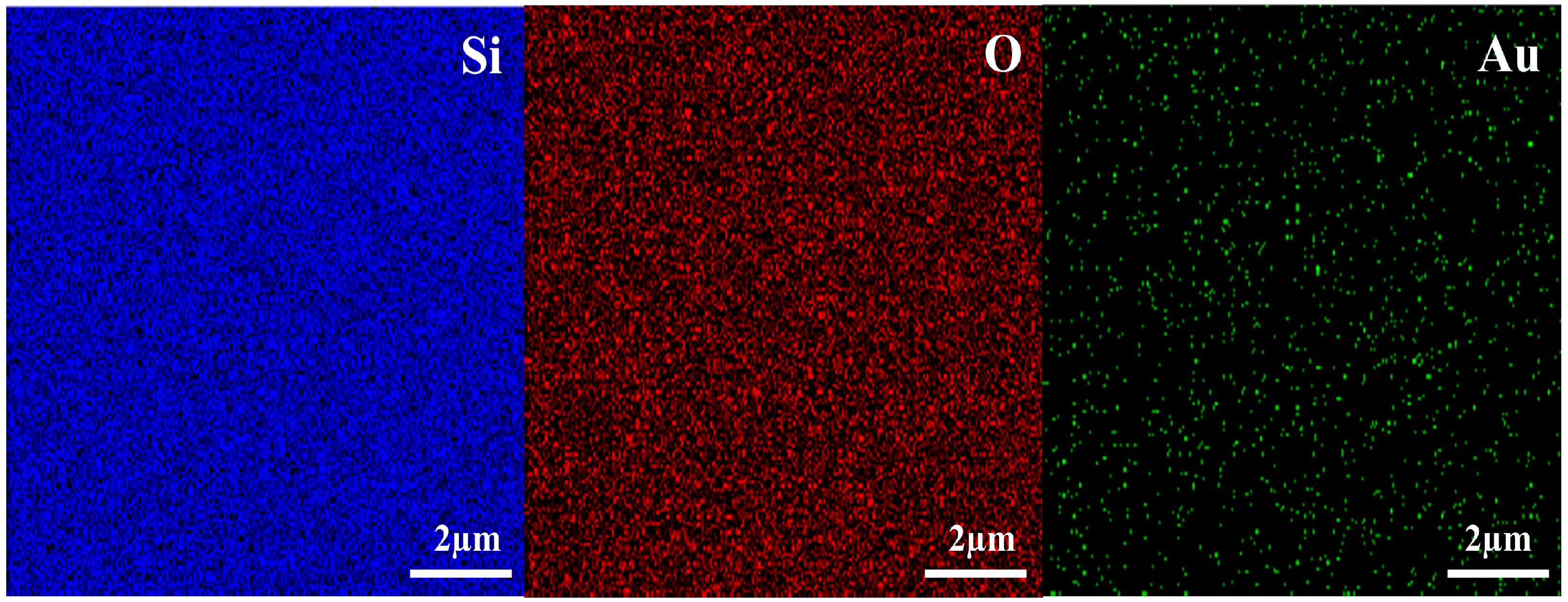
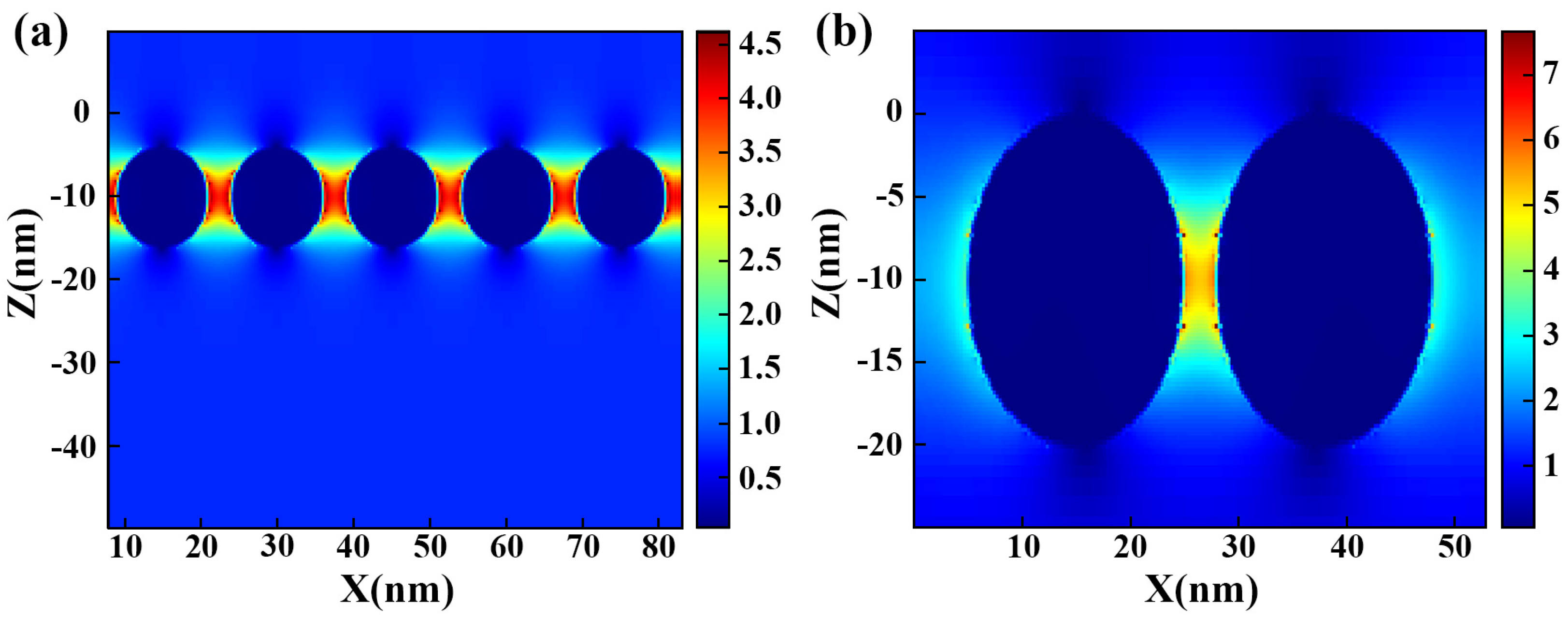
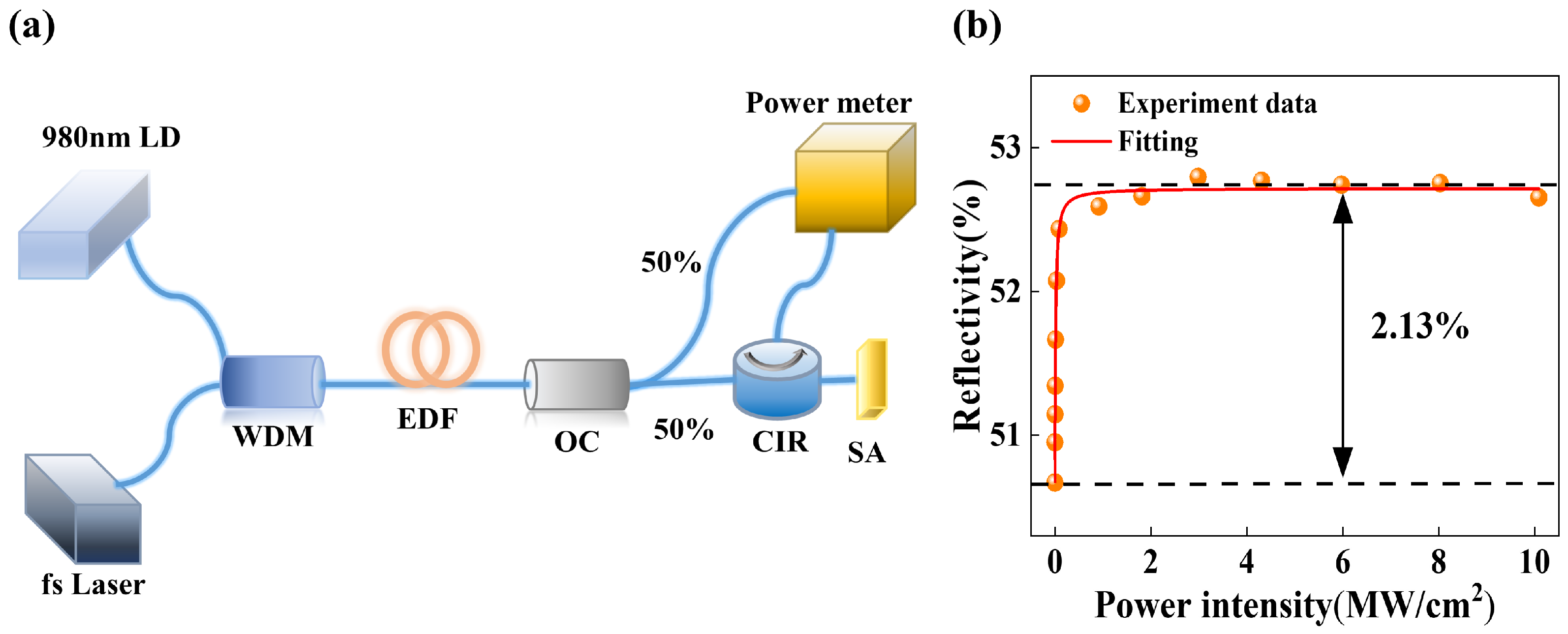

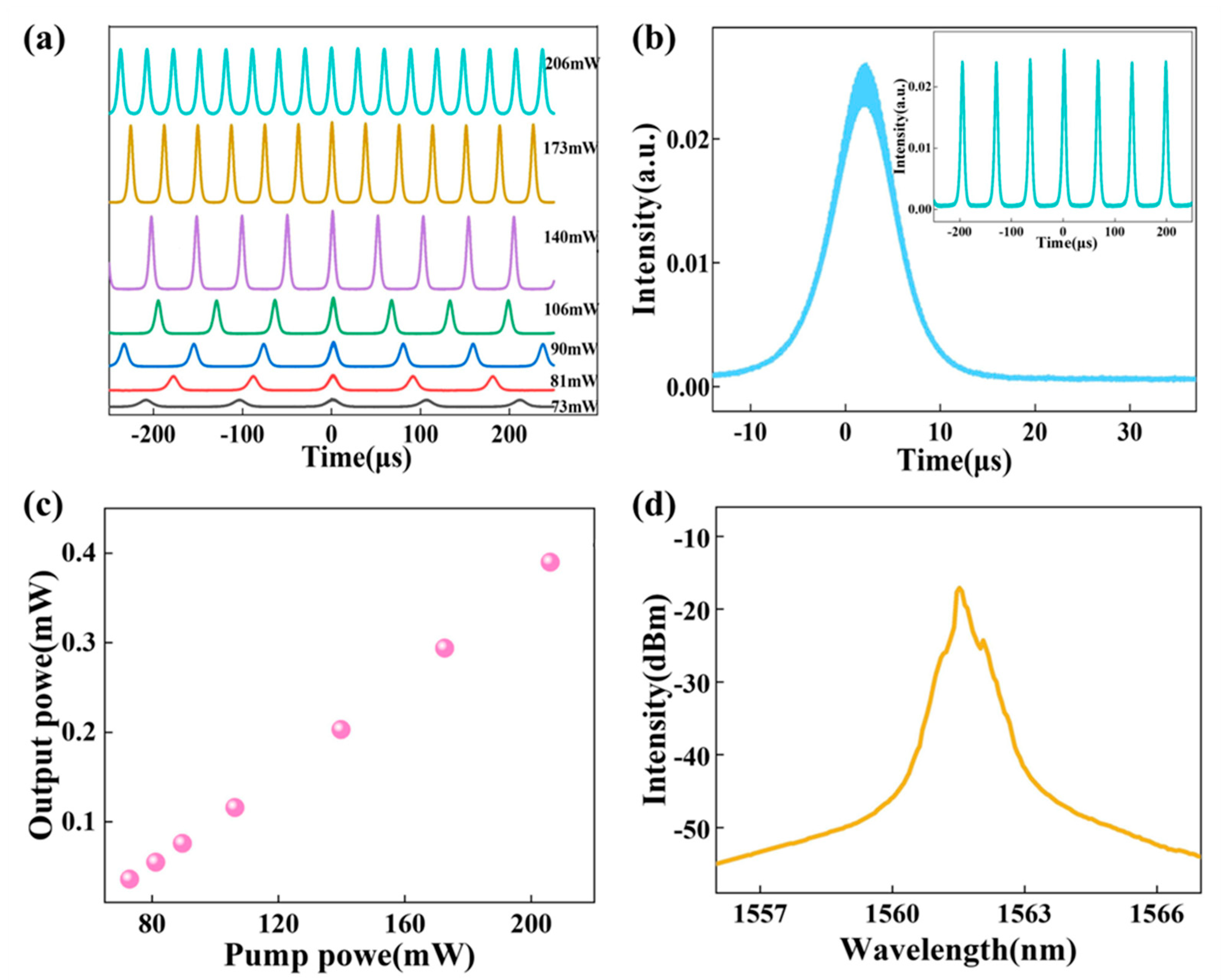
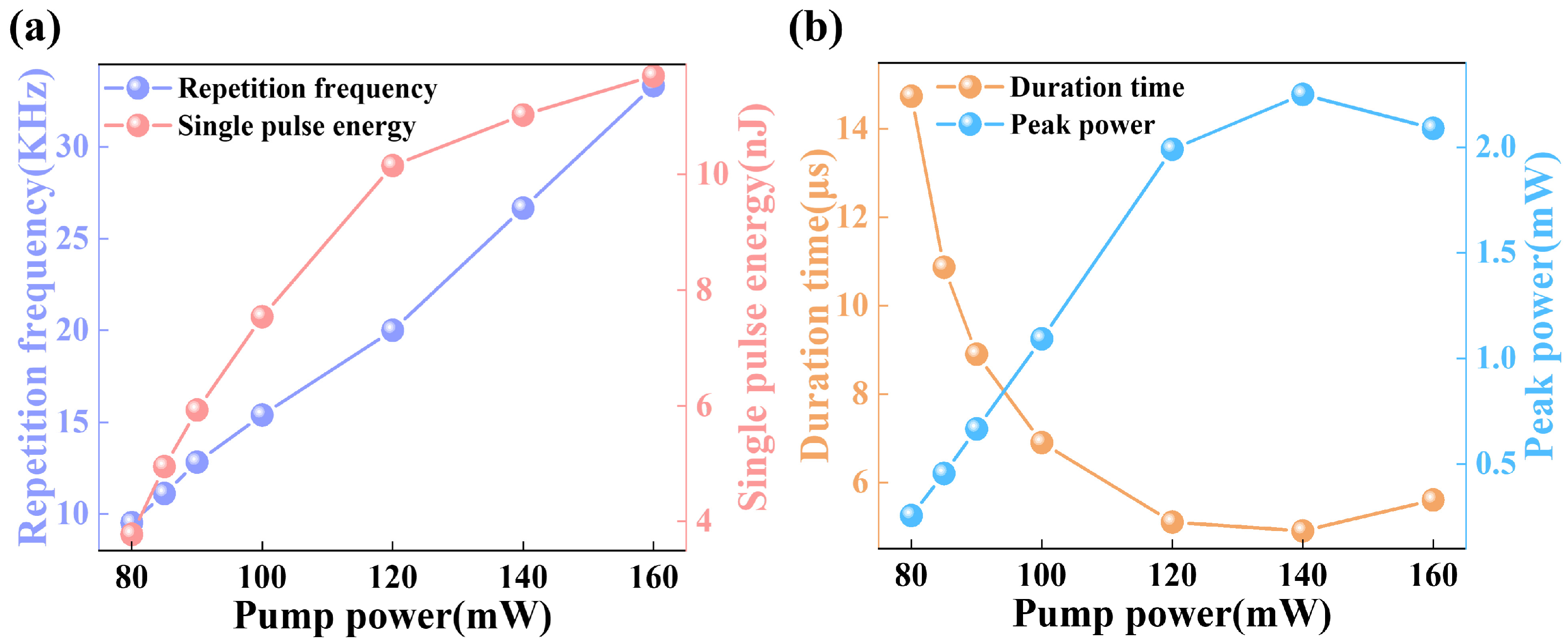
Disclaimer/Publisher’s Note: The statements, opinions and data contained in all publications are solely those of the individual author(s) and contributor(s) and not of MDPI and/or the editor(s). MDPI and/or the editor(s) disclaim responsibility for any injury to people or property resulting from any ideas, methods, instructions or products referred to in the content. |
© 2023 by the authors. Licensee MDPI, Basel, Switzerland. This article is an open access article distributed under the terms and conditions of the Creative Commons Attribution (CC BY) license (https://creativecommons.org/licenses/by/4.0/).
Share and Cite
Chu, H.; Wang, H.; Huang, Y.; Dai, H.; Lv, M.; Zhang, Z.; Jiang, C. Investigation of the Optical Nonlinearity for Au Plasmonic Nanoparticles Based on Ion Implantation. Nanomaterials 2023, 13, 2662. https://doi.org/10.3390/nano13192662
Chu H, Wang H, Huang Y, Dai H, Lv M, Zhang Z, Jiang C. Investigation of the Optical Nonlinearity for Au Plasmonic Nanoparticles Based on Ion Implantation. Nanomaterials. 2023; 13(19):2662. https://doi.org/10.3390/nano13192662
Chicago/Turabian StyleChu, Huiyuan, Hongpei Wang, Yancheng Huang, Hao Dai, Menglu Lv, Ziyang Zhang, and Cheng Jiang. 2023. "Investigation of the Optical Nonlinearity for Au Plasmonic Nanoparticles Based on Ion Implantation" Nanomaterials 13, no. 19: 2662. https://doi.org/10.3390/nano13192662
APA StyleChu, H., Wang, H., Huang, Y., Dai, H., Lv, M., Zhang, Z., & Jiang, C. (2023). Investigation of the Optical Nonlinearity for Au Plasmonic Nanoparticles Based on Ion Implantation. Nanomaterials, 13(19), 2662. https://doi.org/10.3390/nano13192662




